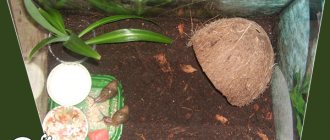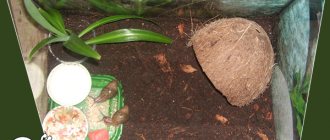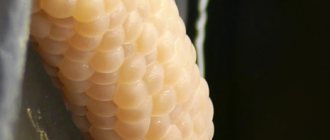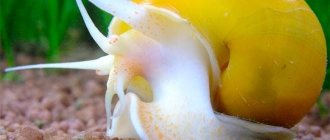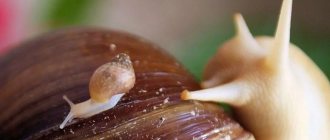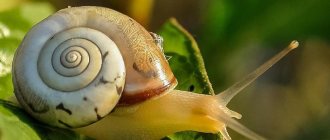Manufacturing and arrangement
Given the growing popularity of snails as pets, today a rather pressing question is how to set up a terrarium for Achatina. A do-it-yourself terrarium for Achatina snails can be made from any transparent plastic box. The main condition for a homemade terrarium is its volume , which should be at least 30 liters. Buying a regular plastic container will significantly save your budget than purchasing an aquarium of the same volume.
Types of houses for Achatina
Several options may be suitable as an utilitarian:
- Aquarium for fish. It is good because it uses environmentally friendly material – glass. In addition, it is not difficult to buy it - it is sold in any pet market. However, ventilation problems may arise.
- Terrarium. This option will also most likely require solving the ventilation issue. Disadvantages include high cost, high weight and reduced impact resistance. But glass is chemically neutral and more transparent than plastic.
- Plastic container. In this case, there will be no problems with ventilation. To make a terrarium for snails ventilated, it is enough to drill two small holes from 5 to 6 mm on two opposite sides. Holes are drilled on one wall 3-4 cm from the top edge, on the other - 3-4 cm from the base.
You need to take a close look at the quality of the plastic itself. It is important that it is labeled “food grade”. The obvious advantage of plastic containers for Achatina snails is their budget cost. You can buy it even with a limited supply of funds. In addition, there is always a wide selection of shapes and sizes, impact resistance, ease of operation, and low weight. Another plus is that plastic heats up slowly and has poor thermal conductivity, so your pet will avoid sudden temperature changes.
- Another option is a homemade ulitharium. But to make it practical and convenient, you will need to know the principles described above. At the same time, houses made of plywood and cardboard are definitely not suitable.
It can also be noted here that Achatina is a mollusk with a terrestrial lifestyle. This means that the best option would be a horizontal terrarium for snails.
Terrarium houses for Achatina
All snails are nocturnal animals. During daylight hours they rest in shelters. Therefore, in artificial conditions, Achatina needs a house. They can serve:
- half a coconut shell;
- bark of tree;
- snag or woven branches;
- as a last resort - a small ceramic flower pot (you need to put wet moss in such a house).
If the snail has nowhere to rest without prying eyes, the mollusk will experience stress. The pet will stop eating and may fall into a state of suspended animation.
Types of soil for snails
African snails cannot live without soil, since they sleep in it, lay eggs, and the soil helps maintain the necessary humidity in the terrarium, and also, if a snail falls off the wall or lid, the soil will prevent it from breaking. Examples of popular soils for snails.
Permitted soils
- Coconut substrate is an inexpensive and most common type of bedding for a terrarium. It holds moisture well and does not stain the walls and snail.
- Peat is an inexpensive type of soil. It holds moisture well, but it is better to use it in a mixture with other types of soil.
- Moss is an affordable and favorite type of bedding. Holds moisture and serves as a kind of indicator of humidity in the terrarium. The walls and snail are always clean. Prevents the appearance and reproduction of midges.
- The soil is good soil, it retains moisture and snails thrive in flower soil.
- Leaf litter serves as an independent and additional type of soil for the snail. She buries herself in it and rests during the daytime.
Prohibited soils
- Sand - scratches the shells and body of the snail, clogs the food system, which leads to the death of the mollusk.
- Sawdust is not Achatina’s favorite type of soil and is dangerous to its health.
- Stones are prohibited, as the snail can break on this type of bedding.
It is also not recommended to use clay and fatty loams as soil for African clams.
Read also: How to make sushi without a mat
Setting up a snail house
The owner of African snails can approach the issue creatively and independently arrange the home of his pets. In this case, you can think of comfortable conditions for both daytime and nighttime recreation.
The basis of a homemade house can be pottery shards, pebbles, and shells. You can line one part of the tank with soil, the other with decor, since some of the Achatina love soil, while others have a weakness for stones. Already while observing the mollusk, the owner will be able to understand its preferences.
You can use a small saucer as a container for water; the snail can climb into it without the risk of drowning. It is advisable to plant the terrarium with living vegetation - ivy, ferns, moss. These plants thrive in environments with high humidity. Ivy is an excellent solution for modest-sized containers.
An ideal terrarium for Achatina snails
Many factors are important - from the size of the tank to its decor - after all, we are not talking about ordinary, but about exotic mollusks:
- When calculating the volume of the tank, it should be taken into account that one clam requires at least 10 liters. It is worth immediately taking into account that, although in captivity Achatina does not grow to the same gigantic size as in the natural environment, they are still quite large snails;
- for a 30-liter container, a couple of Achatina are enough - however, if they live in comfort, then you won’t have to wait long for the appearance of offspring;
- such a pet will not run away, but it may well crawl out of the tank, so it is advisable to provide it with a lid with holes - this will provide both protection and ventilation;
- the ideal size of a house for snails is a height of at least 20 cm, a width of 35 cm;
- direct sunlight is harmful to Achatina, they can lead to the death of the pet, so the terrarium should be installed in a dark place;
- in a terrarium or aquarium, the bottom should be covered with a layer of soil - moss and coconut substrate are ideal for snails;
- Achatina should have several feeders - everyday food is placed in one, additional feeding is placed in the others: a grain mixture, a composition with eggshells, feed chalk, rolled oats, etc.;
- There must be a container for swimming - made of plastic material, with low sides and a small volume of water so that the snail does not choke (it will not splash or dive, it just enjoys being in the water);
- all tanks, bowls, etc. should be secured, otherwise the snail may turn everything over with an awkward movement;
- in order to maintain and monitor readings of temperature, humidity and other parameters, the container must be equipped with a thermometer, hydrometer and other instruments;
- The terrarium requires weekly general cleaning; to maintain constant cleanliness, you can prepare a sponge with good absorbent properties.
Special attention should be paid to the soil, as it performs several important functions at once:
- maintains humidity in the tank - to do this, it is enough to spray it 2-3 times during the day;
- many Achatina prefer to rest during the day, buried in the soil - therefore its layer should be thick enough and the consistency should be loose;
- the substrate is also a place for laying eggs - it makes the future offspring cozy and warm;
- the soil eliminates cases of injury to snails when they slide off the walls or lid of the tank and fall to the bottom (it often happens that when falling from a height, Achatina’s shell breaks and the animal dies).
Container as a terrarium
Many Achatina owners take the simple route and keep their African charges not in terrarium aquariums, but in plastic boxes. How suitable is such housing for exotic snails? As it turns out, a container is an excellent option when it comes to a 30-40 liter container. The ideal option is a transparent box with a removable lid and holes that provide adequate ventilation.
The minimum height of the walls of the tank is 20 cm, length - 30 cm. Naturally, if the owner is going to breed Achatina, he should take care of a spacious house for his inhabitants, the number of which will increase over time.
As in a terrarium, the container must be maintained at a certain humidity level and the container should not be placed in the sun. In no case should shellfish bask in direct sunlight - this will cause dehydration of the animal and its death.
If the snail's house is an ordinary container, a box should be placed in it, the bottom of which should be covered with substrate. The thickness of the substrate layer for large snails should be at least 10 cm.
For these purposes, you can buy a package of special soil or loose sand at a pet or gardening store. When choosing a suitable substrate, you should focus on the pH of the composition, which is usually indicated on the package. It is best if this indicator is 7.0. If you place soil with low acidity in a tank containing snails, this can damage the skin or shells of the inhabitants.
If soil from your own garden plot is used as soil, it must first be sterilized - in a hot oven or refrigerator. Otherwise, infection or parasites may enter the house.
Proper ventilation for snails
On the Internet you can see photos of containers with ventilation on the lid. This is wrong and at the same time, no. People are so used to it. They open the container for ventilation, fluff up the soil, and remove leftover food every day to prevent it from rotting. Why make life so difficult? There is an easier way to provide the snail with fresh air and humidity.
How to do it?
Ventilation holes are made above the ground (10 mm from the surface) along the entire length of the terrarium wall. The optimal diameter of the holes is 2 mm, a thin drill, an awl or a nail can easily cope with this task. The distance between the holes is 2-3 cm. It is worth saying that the ventilation holes can be in one or two rows, it all depends on the height of the terrarium. To improve traction, additional holes are made in the opposite wall below the cover.
Terrarium dimensions
In order for the snail to fully grow and develop, so that its shell is large, it is necessary to calculate the volume of the terrarium based on the norm - at least 10 liters per individual. But I would still advise buying a larger terrarium. I currently have a 15-liter container, but over time I’m thinking of increasing the pet’s living space to 20-25 liters.
If you are taking a newly born snail, buy a 15-liter terrarium in advance. At first, you can keep the snail in a small food container, and when it grows a little, transplant it into a 15-liter container. The snail grows very quickly, so do not buy several containers, as after a couple of weeks a 5-liter container may become irrelevant. My Achatina has been living in an adult terrarium since the age of 4 months, that is, from the moment of purchase.
It is important that the lid closes tightly
An important criterion is the height of the house. Don't buy a vertical type container. It should be wide, long, but low. Snails love to crawl on the roof, from where they periodically fall. And a fall from a height is fraught with injuries to the shell.
The optimal container height is 17-22 cm. Width is 23-30 cm. Length is 35-40 cm. These parameters exactly correspond to an approximate capacity of 15-20 liters.
I also don’t recommend very low options - less than 17 cm in height, since an adult snail will not be able to stretch out, it will be cramped and the shell may get stuck, standing between the bottom and the lid of the container while the pet is moving.
Where to place
These pets are not very picky about environmental conditions, but the minimum parameters must still be observed. Otherwise, the individuals will feel uncomfortable and will most likely die. They like quiet places, protected from pets and sunlight. It is advisable to place it in rooms with high humidity and sufficient temperature. The box must contain a substrate for the substrate.
Adults prefer a deep base - at least 7 centimeters. It is best to use ready-made soil options, which are sold in gardening stores; such soil does not contain harmful impurities. You need to check in advance such an important parameter of the substrate as pH (it will be written on the packaging). A pH level of 7.0 will be sufficient; lower values will negatively affect the condition of sensitive skin and sinks.
How to organize a safe house for a snail
After choosing a suitable container, the shellfish should not be immediately released into a new home for domesticated snails. It is important to first properly organize the internal space so that exotic individuals do not experience stress from unexpected relocation.
Here are a few important steps that need to be taken to arrange the Achatina house:
- Step 1 – proper ventilation. Without a constant flow of air, new residents may die, and all sorts of pathogenic bacteria will appear in the terrarium. For good ventilation it is important that the holes are drilled in a certain sequence. Namely, in the lid of the container, in the upper part on one wall and in the lower part on the opposite wall. Air circulation will cover the soil and the general space of the snail house.
- Step 2 – choosing bedding. To make the clam feel warm and cozy in its new home, the owners choose a variety of substrates, live forest moss, leaf litter, peat, driftwood and other decorations.
- Step 3 – maintaining temperature and humidity. The terrarium must be kept away from open windows, heating radiators and hot rooms. But at the same time, the house must be maintained at a constant temperature of 24-27 degrees and humidity at 70%. To monitor parameters, heating mats, thermometers and sensors are used. They will tell the owner if any conditions in the terrain deviate from ideal.
- Step 4 – water. A saucer with life-giving moisture should be constantly available to the inhabitants of the terrarium. In a flat container, the depth of the liquid should be no more than 1 cm so that children and adults cannot choke and drown. You can buy a beautiful drinking bowl.
The last step remains - placing small, sensitive pets in a new home. It is very important that you closely monitor the babies during the first 24 hours. If they don’t like the conditions of detention, Achatina can go into hibernation for a long time.
How to build a terrarium for “Akhatinki” yourself
These mollusks like a subtropical, temperate climate, and even a slight drop in temperature can cause their death. Therefore, owners must provide their pets with suitable conditions. In addition, Achatina requires a special tank - a terrarium, in which it is necessary to reproduce with maximum accuracy the environment familiar to these animals.
Many owners of Achatina use a regular aquarium; in it you can create an excellent imitation of natural conditions. In such a tank, the snail will be protected from drafts and cold air, it will remain at room temperature and it will be easy to maintain suitable humidity. The owner should be wary if his ward has become inactive - in this case, there is a risk of death of the Achatina, and most often this happens due to the inattentive attitude of the owner.
How to choose a place for a container with snails
Direct sunlight is contraindicated for Achatina, so you can place the terrarium on a bedside table or shelf away from sunlight and drafts. Do not place the snails' home near a radiator or radiator, as they will get too hot and may die.
Decorate the container on both sides with fresh flowers or artificial plants, let it be a corner of exoticism and relaxation.
Why can't you use gauze as a lid?
If the terrarium is not covered with a lid, all the moisture from it will evaporate. You will have to constantly moisten the soil and the walls of the container. However, the air will remain dry and the soil will become wet. This difference is bad for the health of snails.
The same can be said about aquariums with poorly fitting lids. Of course, the moisture will not disappear as quickly as through gauze. However, you can choose the frequency of irrigation and its abundance, but this must be done under the control of a hygrometer.
How to make proper ventilation
The snail does not need a lot of oxygen, but even it needs an influx of fresh air. The air dries the soil in the terrarium, preventing mold and unpleasant odors from forming. On the Internet, there are two opinions regarding ventilation in Achatina dwellings. Some argue that it is enough to make a few holes in the lid of the terrarium and this will be enough for a comfortable life for the mollusk.
If you notice that the soil is drying out quickly, seal several holes.
Others argue that air should not only enter the terrarium, but also exit. Proper air circulation is ensured by holes on the walls of the terrarium. On one side - at ground level, on the other side - just below the terrarium lid. The holes should be no thicker than a match.
If you have a terrarium for hamsters, seal half the holes on the lid to prevent the soil from drying out quickly.
Tank cover
It is important that the Achatina house is regularly ventilated, and that the humidity in it is stable. And if the container is not covered, then the aeration will be too strong, as a result, the humidity will steadily decrease. A lid will help solve these problems; in order for moderate ventilation to continue, there must be holes in it. They can also be done using an awl and in the walls of the tank itself.
You can make a window in the lid of the container and block it with a piece of mosquito net, gluing it on the outside with superglue. It is important that occupants do not come into contact with the adhesive. This precaution will prevent insects from entering the terrarium. The soil should always be clean, moderately moist, but not soggy.
If regular spraying of water does not help, and the air in the tank quickly becomes dry, then you can cover the holes in the walls or lid with plastic film, which will provide a “bath” effect.
Plants and accessories
Decorating a tank with snails allows you to realize numerous creative ideas of the owners. You can decorate the space using a variety of branches, driftwood and cones, combined into unusual compositions. The components must be disinfected if we are talking about objects assembled with one’s own hands, or simply purchased at a specialized store. You can also arrange the tank using beautiful moss - either decorative or forest. Again, the moss that you collect yourself must first be soaked for half a day in cool water, then doused with boiling water and finally placed on top of the ground.
It’s easy to decorate a terrarium if you use a variety of ivies, ferns or young plants.
Live varieties are likely to be quickly nibbled by Achatina, so for long-term use it is recommended to take artificial versions. When selecting decorative components, it is important to avoid hard and hard objects. Half a coconut would also fit well as decoration. We must not forget that arranging a “home” is impossible without placing a special bowl with clean water. Since snails prefer to swim in it, the container should be medium-sized and highly stable.
It is not recommended to use stones, grottoes made of clay, or decorative shells in an aquarium. All these materials can damage the soft body of the mollusk, or even the shell.
These creatures do not need shelter, so excessive decoration will most likely have a detrimental effect. Among plants, experts recommend choosing succulents that look extremely stylish but do not require any special care. The plants have a hard stem that Achatina cannot break. You can plant lettuce or pre-sprouted wheat grains in the aquarium. Of course, after some time the snails will eat them, but for a certain period of time you will still be able to enjoy the unusual design.
How to care for domestic Achatina
Giant African snails have significant advantages - they are quiet, non-messy and odorless pets that do not require regular walks and other activities. But this does not mean that they do not require care:
- the house of exotic inhabitants must be thoroughly cleaned once a week;
- Achatina is bathed - carefully, without a contrast shower, spraying them with a spray bottle. Both hot and cool water can harm shellfish;
- The snail's shell needs special care - it must be examined for diseases and damage; if plaque, stains, chips, or cracks are detected, it is recommended to consult a specialist;
- if it is not possible to visit a veterinary clinic or there is no specialist involved in the treatment of mollusks, you can use a non-toxic adhesive.
It is recommended to care for the Achatina shell as follows:
- strengthen its material - in order for the shell to be strong and resistant to various types of damage, it is recommended to treat it with a mixture of calcium or crushed shells;
- damage to the shell of snails can heal without outside help, but in order to stimulate the process, they can be sealed with non-toxic glue or a layer of plaster;
- many snails are quite aggressive animals and are capable of chewing off the limbs of other inhabitants of the tank. Snails, which seem like a “delicacy” to neighbors, should smear their shells with Vaseline to discourage the voracious residents’ appetite;
- A preventive measure is to treat the terrarium with a weak solution of potassium permanganate. This avoids the development of mites and fungi in the container.
Feeder, drinker, bathing
Unfortunately, snails are not very careful. Moving around the terrarium like a miniature tank, the mollusk literally sweeps away everything in its path. Therefore, it is natural that objects placed in a container must be properly secured. A small bowl dug into the ground will serve as a feeder for the snails.
As you can see, these cute clams do not require complicated care. You can take the snail terrarium, photos of which are presented in our article, as a basis. Achatina are excellent pets for people suffering from allergic reactions. It is interesting for children to care for and watch snails. This will be one of the baby’s first acquaintances with wildlife and its representatives.
And you will learn about how long Achatina snails live from this article.
Features of caring for Achatina offspring
The clutch of snails is located in the thickness of the substrate all the time until the babies appear. The environment should be moist - if the soil is dry, the eggs most often die. It is not worthwhile to moisten the soil, as this can cause the death of offspring. The optimal air temperature for snails is 28°C. You should not touch the eggs with your hands, as the delicate shells can be easily damaged.
The next stage: caring for young Achatina. Individuals do not require any complex procedures. One mollusk can lay up to 75% of the eggs, and three weeks later, snails hatch from them. In some cases, it can take 4 weeks from the moment the eggs are laid until the babies hatch.
The offspring are separated from their parents, and when the young grow up, the individuals are placed in different tanks - this will prevent uncontrolled mating and reproduction.
Selection of accessories and plants
You can beautifully decorate an aquarium for a clam with your own hands using live and artificial vegetation, decorations and decorations
When choosing decorations, it is important to make sure that they are made from environmentally friendly materials and are safe for your pet’s health. In addition, jewelry should not have sharp edges, otherwise Achatina will injure the delicate body
The following will look harmonious in the terrarium:
- Cones, twigs and driftwood, pre-treated from bacteria or purchased in a store.
- Moss – decorative or forest. If the moss is brought from the forest, it is soaked for 12 hours in cool water, scalded with boiling water and laid on top of the substrate.
- Living types of flora: ivy, ferns, mosses, juveniles. When planting living flora, you should be prepared for the fact that some of the plants will be gnawed by Achatina. Artificial flora is considered a more economical and practical option.
When choosing decorations, you should avoid hard and rigid objects with sharp edges.
In an aquarium with Achatina, be sure to place a bowl of clean water, because snails love to take water treatments. Choose a medium-sized bowl that is stable so that the container does not tip over.
African Achatina are funny and intelligent pets that get used to their owner and recognize the owner by allowing themselves to be stroked. For a long life, the mollusk should be provided with a properly equipped house in which the snail will be calm and comfortable.
Selecting a primer
Soil performs certain functions. Based on them, you should decide what and how to choose soil for the terrarium. In terms of quality, it must correspond to its purpose:
- Achatina sleeps in the soil, lays eggs, and digs through it in search of food;
- the soil is saturated with moisture and retains it, which helps maintain a constant level of humidity;
- if an animal falls off the wall of an artificial dwelling and falls to the bottom, the soil will soften the fall;
- Living vegetation is planted in the ground.
The substrate must be kept moist at all times, and the soil should be loosened regularly. In addition, it must be safe for shellfish - no fertilizers or parasites.
In African snails, due to their inherent rapid metabolism, the soil quickly becomes dirty with waste products. Therefore, it is important that changing it is easy and quick. Experienced snail breeders know this life hack:
- Take a plastic bag with a bottom that is equal in area to or slightly larger than the bottom of the terrarium.
- The bottom is cut off from the bag with “sides”.
- The bag is placed at the bottom of the terrarium, and soil is poured into it.
- The edges can be camouflaged with snags, dry leaves and moss.
Thus, to clean the terrarium for Achatina, you just need to remove the bag of soil and replace the entire structure with a new and clean one.
Special requirements for the terrarium
To prevent Achatina from dying, owners should follow a number of simple conditions when creating an artificial microclimate.
Snails don't like sunlight
These include:
- The aquarium must have sufficient volume, at the rate of 10 liters per adult Achitin snail. When buying an aquarium, it is important to remember that as Achatina develops, it increases significantly in size.
- Ventilation. To prevent snails from leaving the terrarium without permission, it should be kept closed. But it is important to remember that snails, like most living creatures, need constant access to oxygen. For free air circulation, the aquarium lid must have small holes (perforations).
- Direct sunlight has a detrimental effect on snails, so it is important to place the Achatina snail aquarium in a dark place.
And in order for the container (terrarium) to become a winning element of home decor, its design can be completed with interesting touches.
Terrarium material and tips for choosing
The main materials of the terrarium are either glass or plastic.
Since the Achatina snail is a fragile creature, I do not recommend buying a glass terrarium . Of course, the soil at the bottom of the terrarium will soften the snail’s fall from the roof of the container, but why the extra danger? The snail will dig into the soil and the glass floor may become exposed. What if at this moment your pet falls with its shell directly onto a hard surface? In addition, when a snail grows to a large size, its shell can hit the walls of the terrarium when moving, which can also be traumatic.
Another drawback is that glass is slippery and it may be uncomfortable for an adult snail to constantly slide along the walls of such a terrarium, and the number of falls from the roof will increase.
The glass house is quite heavy and cleaning it regularly is not very convenient.
The advantage of glass is its environmental friendliness. Glass stays clean longer and bacteria do not grow on it compared to plastic. But in my opinion, this option is not the best for snails.
So I chose plastic and my snail has been living in a plastic terrarium since the moment I brought it into my house.
Plastic is very convenient to use as a terrarium for the Achatina snail. It is lightweight, it can be placed anywhere in the house, and can also be moved around the house if, for example, you want to put a house with a snail on the sofa in the evening and watch the pet.
Terrarium made of food plastic
There is no need to worry that the house will split during use, and even with a minimal amount of soil, it is practically impossible that the snail will fall and damage the shell. Of course, if the snail is still very small, and the terrarium is high, it could be injured if it falls from the roof, there is no need to experiment with the absence of soil.
- Pros: environmental friendliness and aesthetics.
- Disadvantages - dangerous for the pet, difficult to clean, not mobile, heavy, quite expensive, more difficult to provide optimal ventilation (read the article further and you will understand why).
- Pros: light in weight, easy to clean, mobile, safe for pets, cheap.
- Cons – less environmentally friendly than glass. Over time, you may have to buy a new one. And it doesn’t look very aesthetically pleasing compared to the glass version.
Feeding regimen and diet
An important aspect of keeping giant snails is that if the pet does not get everything it needs, it will get sick and die. Achatina should not be given:
- acid;
- calcium;
- salt,
- sour foods, confectionery and flour products;
- potato;
- green tomatoes;
- sweet foods and drinks;
- smoked meats;
- roast.
In their natural environment, these snails eat almost everything - from rotting plants to citrus bark. They grind food with a tongue covered with spines with a keratinized surface. They do not refuse carrion, mushrooms, algae, and lichens. At home, Achatina is fed with melon, pumpkin, greens, salad plants, sunflowers, eucalyptus leaves, legumes, onions, potatoes, spinach, and young corn.
It is useful to give your pets shoots of cereals and vegetables, tops from beets and carrots. You can also diversify your pet’s menu with young birch, linden, apple or oak leaves, freshly squeezed juice from pumpkin, carrots, peach, pear.
It is worth noting that young animals of this breed love to eat living vegetation, while adults prefer rotting remains. Many owners have real picky eaters waiting for something “tastier.” But usually such behavior can be corrected, and, without waiting for a tasty bonus, Achatina begins to eat what the owner offered them.
Until recently, Achatina in Russia was truly exotic. Sellers quickly sold these overseas inhabitants, and the army of fans of giant snails grew steadily. Today, many people keep these mollusks and even produce offspring, which confirms that caring for them is not as difficult as it seems.
